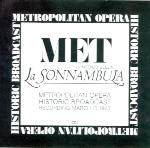In 1963, the opera world finally was becoming accustomed to Joan Sutherland, who had become an overnight star four years previously at Covent Garden. Here was a gigantic voice, one with the heft of a dramatic soprano (I often heard her live and can attest to the fact that her sound had the potency and breadth of Nilsson’s) that also was able to execute the most intricate fiorature faster and more accurately than any soprano in memory. She had an absolutely perfect trill, breath control suggesting a third lung, and an ability to maintain her voice’s rich, vibrant, huge, and beautiful quality up to radiant high Cs, Ds, and Es. Of course she had her problems: she was a relatively ungainly actress, her diction was abominable (since ravishing, rounded tone was everything, she tended to disregard those pesky consonants), and she tended to “droop” in slower, non-pyrotechnical passages. Occasionally damned as the anti-Callas because of her seeming disinterest in the dramatic content of the roles she sang, everyone soon gave in, acknowledging that while she certainly wasn’t Callas, she definitely was Sutherland, and the bel canto revival begun by the former had been differently ignited in her.
Sutherland recorded the role of Amina in Sonnambula twice commercially, once in 1962 and again in 1980. Of course she’s fresher in the first, but the second boasts the still-great Pavarotti in a role that (I believe) he never sang on stage and wouldn’t dare–it simply sits too high, even for him at his best; and besides that, Sonnambula belongs to the soprano. And this set, taped live from the Met in 1963, certainly does belong to Sutherland. About 15 minutes of the score is cut (“performance cuts,” they’re called, to save the singers) but Dame Joan (a.k.a. “La Stupenda” by the Italians, incidentally) sounds as if she could start the opera all over again when it’s over and sing it just as gloriously. It’s all here–the ease, grace, dazzle, sweetness, and accuracy–and furthermore, since it’s a live performance, Sutherland’s more engaged dramatically than in the studio. Hear this and be amazed.
There are only two other roles in the opera with any importance and they’re also beautifully filled: the wonderful Nicolai Gedda, then in his prime, sings Elvino with true bel canto line and technique to match Sutherland’s, tossing off high notes as easily as she does; and the normally dull Ezio Flagello sings the bass role of Count Rodolfo with big, firm tone. The Met chorus and Orchestra are excellent under Silvio Varviso’s leadership and the broadcast sound is very good. Even if you own another Sonnambula (and everyone should own a Callas performance), this one will give you hours of pleasure and make you nostalgic for Sutherland, even if you never heard her live. In a way, she was her own Golden Age, and this set proves it. The CDs are available through the Metropolitan Opera Fund, Box 930, New York, NY 10023.
































